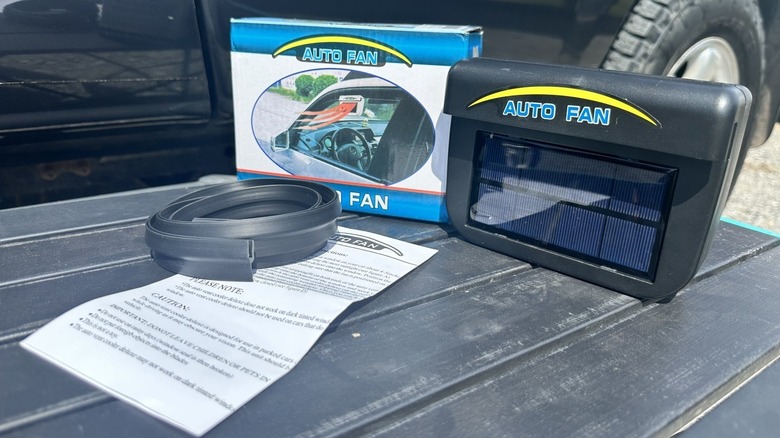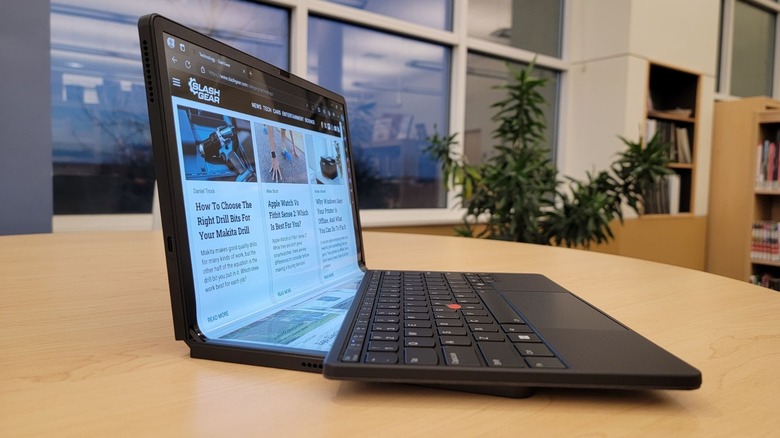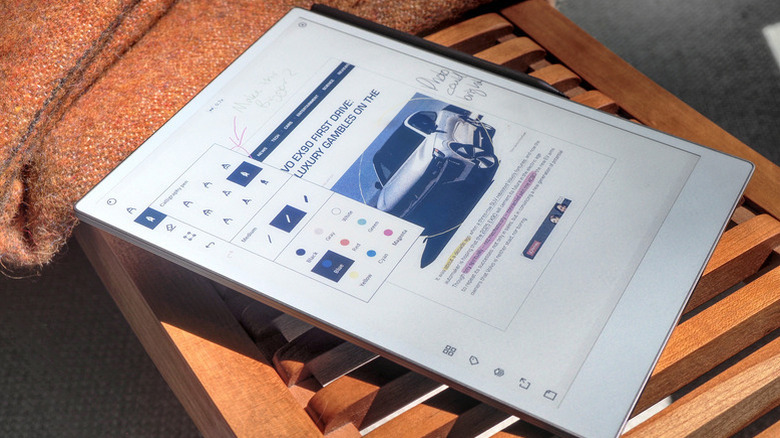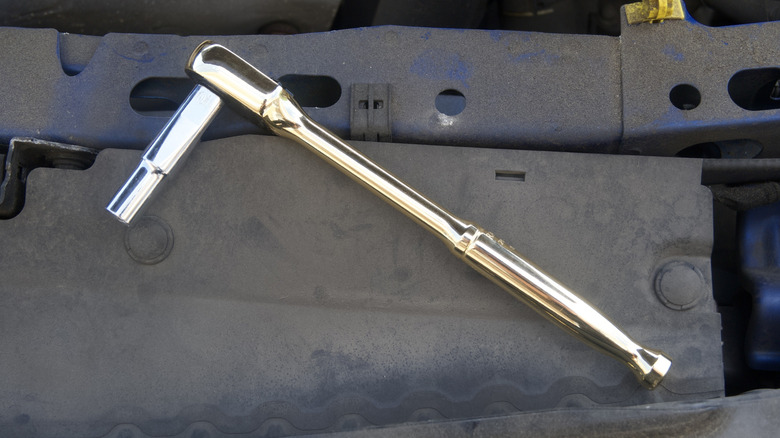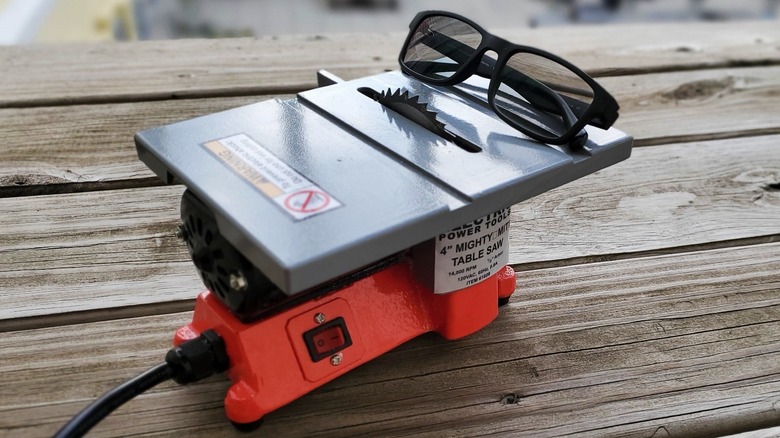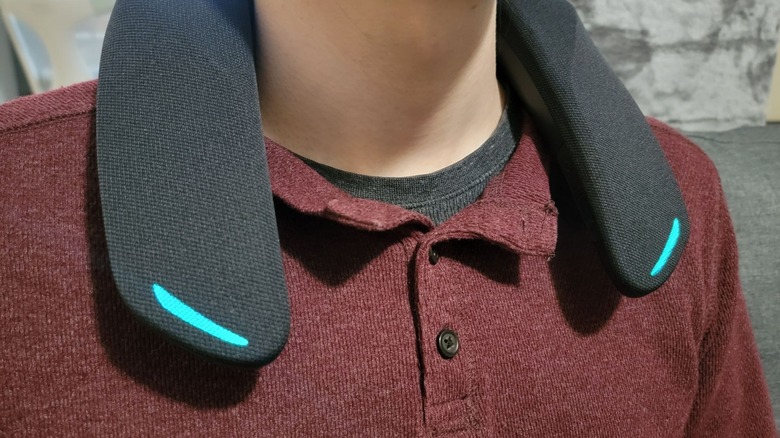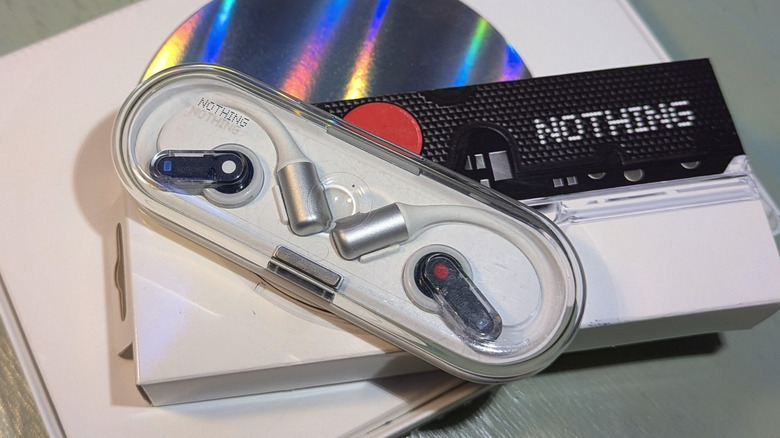10 Of The Weirdest Products We've Tested In 2024
The tech industry is no stranger to weird gadgets. Back in the '90s, it was the Palm Pilot and the pager. In 2024, it's the Humane AI Pin and the Rabbit R1. Some end up being weird in a good way; despite how bizarre it may seem now, the page dominated until cell phones became commonplace. Some are the opposite; both the Humane AI Pin and the Rabbit R1 were panned in their reviews and are currently swirling the drain. More tech hype for the scrap pile. At SlashGear, we love gadgets and products of all kinds, so we've seen our fair share of the weird just in this year alone.
Some are weird yet somehow scratch that itch for a product you never realized you needed. Some are just bizarre and out there, requiring an edge case to be worth the money. Some don't make sense for just about any consumer — but hey, a company is selling them, so clearly someone is buying them. Here are 10 of the oddest ones we've tested hands-on in 2024.
Universal socket
SlashGear's Alex Hevesy reviewed the so-called "Universal socket," a product that looks straight out of one of those buy-from-TV ads. Basically, you've got a deep well socket almost identical to the ones in your tray set, but instead of having it only fit one specific hex-shaped head, it fits... well, almost anything, even if said thing wasn't designed to be fastened via socket. It does this with a series of pins that conform around your desired object and lock it into place so you can tighten or loosen it. Hevesy reviewed the Gator Grip from Endeavor Tool Company for $12.70, but these universal sockets can be had from any one of the many companies that make them. Here's another from Amazon for $9.99.
Hevesy praised it for very niche applications where you may not have the right socket on hand — or better yet, there's no attachment on Earth that would do. For example, screwing in a hook. However, that usefulness fell off sharply when popping the hood of the car and tackling the many different fasteners therein. It only supports a fairly narrow range (between ¼ and ¾ inches), and struggles dearly when going at a bolt that isn't sticking out far enough. Hevesy makes it clear this is not going to replace an entire tray set, but it will be helpful from time to time when that one odd fitting requires it.
Solar Car Fan
Ever noticed how taxi drivers often roll their windows down instead of running the air conditioning? There's a reason. According to the Department of Energy, you can see a decrease up to 25% of your fuel economy doing the latter. In that spirit, the Auto Fan reviewed by Samantha Cataland aims to save some gas via renewable energy, without sparing comfort. It's a solar-powered, window-mounted fan. Cataland tested the Muxan brand specifically, but these are a dime a dozen on Amazon and you can grab whichever suits your fancy.
The device is about as simple as can be. Mount it on the window with the included gaskets and it will run anytime it gets enough sunlight. There's no battery or speed control buttons, and it's only intended to be used when parked, not driving (otherwise, it could block your view.) So, ideal for someone who doesn't want to leave the car idling but doesn't want to pour sweat, either.
Alas, Cataland didn't see any improvement when leaving the fan on during a hot day, and it did little to neuter lingering smells. User reviews seem to agree; just search for this thing on Amazon, and virtually none of them go higher than three stars reviews. It's doing something, sure, but the effect is too minimal. Plus, the window gap the fan leaves presents a security risk since it wouldn't be difficult to remove it and break into the vehicle. So, weird for sure, but unfortunately, not hugely useful.
Lenovo ThinkPad X1 Fold
There's been a trend in recent years towards vertical monitors, and for good reason. Most of the content we view online consists of long, narrow, scrollable web pages and documents. A vertically oriented monitor lets you view more of that at once. Depending on your workflow, that could noticeably improve productivity. The Lenovo ThinkPad X1 Fold reviewed by Sarah Chaney puts a folding vertical monitor into a laptop form factor so you can bring that peculiar configuration with you anywhere. Imagine a big Samsung Z Flip with a keyboard attached to the bottom, and you've got a pretty good idea of how the X1 Fold works.
The X1 Fold is quite pricey at $3,279.50, has only mid-range specs, and has less than stellar battery life, but it does what it sets out to do quite well. You can configure the laptop as a vertical monitor, a widescreen, a clamshell laptop, or even a tablet by detaching the keyboard entirely. Swapping between the modes is easy, and the OLED screen is excellent. Chaney also enjoyed the included Precision Pen.
It's not a gaming PC, nor one for resource-hungry programs like 3D modeling, but it'll handle productivity tasks just fine. The price is really the only major barrier here. You are sure to get a few looks when bringing this thing to the library, too. But hey, those people don't have a cool, folding vertical monitor like you do!
reMarkable Paper Pro
E-ink tablets and readers are no longer confined to Kindles and grocery store price tags. Many of them now have impressive visual fidelity, fast refresh rates, and even color. For those who want to feel like they're using digital paper the reMarkable Paper Pro is one of the better options on the market at the moment. For $579 you get an 11.8-inch screen and a two-week battery life. Upgrade to the Marker Plus stylus for $629.
Reviewer Chris Davies says the screen's texture and quick refresh rate really makes it feel like paper, helped immensely by solid palm rejection and decent text manipulation gestures. However, the file compatibility and connectivity options have some big limitations. You can only open PDF and EPUB files, and aside from some slim support for major cloud storage services like Dropbox, you'll most likely have to subscribe to the proprietary reMarkable Connect for $2.99 a month to properly sync and access files from your desktop. Basic features like sharing are weak, and it doesn't even support things you would expect, like spellcheck.
The reMarkable is clearly going for a simplified, feature-slim, distraction-free experience. It's effectively a glorified paper notebook. Unfortunately, it is quite expensive, especially if you want the pen and keyboard — $858 expensive when fully specced out. Only a very specific type of person is going to find a use for this. You should probably test it well and take advantage of the 100-day return policy. Everyone else should probably just buy the iPad Pro M4, which we quite liked.
Viture One Lite
AR glasses are slowly building up steam as a more accessible (and less geeky-looking) alternative to VR. Viture's One Lite follows in the vein of the Meta Ray-Bans at $349, a way more affordable alternative to the $549 original. Using prism lenses, the One Lite overlays your view with visuals from micro-OLED projectors and plays sound from hidden speakers, complete with a couple of discreet tactile controls. Reviewer Nadeem Sarwar says the device is comfortable to wear for long periods, clocking in at only 76 grams. It also gets a thumbs up for the convenient adjustment knobs and nose pieces that ensure a perfect fit for all.
If necessary, the glasses have sufficiently high brightness to mostly hide the outside world, with sunshades for when it's especially bright out. The 1080p, 60Hz projectors whip up a great image, although head tracking isn't the best. With the included SpaceWalker software (not yet available on Windows) users can AR-ify their desktop or smartphone.
Sarwar notes that it's not yet a complete experience; the software is still very beta, missing a couple key features like screen recording. Some features are, strangely, locked to an adapter you have to buy separately. Some you wouldn't expect to find on a device like this at all, such as support for viewing spatial videos made by an iPhone 15 Pro and above. All in all, Sarwar recommends it over other competing options in the same price bracket.
Harbor Freight 24K Gold-Plated Ratchet
Yes, you read that correctly. The same store known for its dirt cheap tools sometimes sells what looks like a tool a Dubai auto shop misplaced. Alex Hevesy purchased the Icon ⅜-inch 24K gold-plated ratchet for $59.99 (it would be $39.99 minus the gold, in case you were curious). This isn't a cheaply made, throwaway gold plating, either. The manufacturer went all the way with a high-quality electroplating. The tool itself is also plenty good for ratcheting jobs.
While Hevesy didn't have electron microscope to verify 100% that it is 24K gold, the ratchet does appear to be behave like gold. The packaging warns users against scratching it since gold is highly malleable — people bite gold coins to test them, after all. The plating processes leaves only an atom-thin layer on the surface, so the ratchet looks nice and stays at a price point mere mortals can afford. All of this is to say it got dinged up pretty quickly after just a few minutes of auto work.
The only real downsides are that the gold ratchet does not take abuse well and costs $20 more than a normal one. So who is this tool for? The only conceivable benefit is aesthetics and appearance. If you want a fancy looking garage, or to look like an extra in a rap music video, this is for you.
Harbor Freight Mighty Mite
At first glance, the Harbor Freight Mighty Mite looks like a child's toy, but the sawblade is very, very not for children — at least not unsupervised ones. This $30 table saw, reviewer Brittany Roston says, is marketed towards hobbyists who need to cut thin materials (as in, 3 millimeters thin) without buying an expensive rig that would require a garage to use it in. In Roston's case, she makes terrariums, but anyone from a Warhammer miniature crafter to a dollhouse builder might find use here.
However, that $30 price point means compromises were made. Ruston points out that corners were cut with everything from the blade guard to the miter gauge. Still, she makes it clear that you'll be hard-pressed to find a similar saw table anywhere else for anywhere near that price. This saw table is disrupting a small, expensive niche, and doing so quite well. If the Mighty Mite tickles your fancy, do be aware that it's a bit challenging to find; Roston notes that you can't buy it online, and few Harbor Freight locations stock it.
Invoxia Minitailz
Smart, health-oriented devices are getting smaller and more affordable with every passing day — just look at the recent Samsung Galaxy Ring. It only makes sense that some of that tech would trickle down to pet owners who want to keep track of their beloved furballs and know how their vitals are doing. Think of the Invoxia Minitailz as an Apple Watch for pooches. This collar attachment is for the bigger pets — teacup Chihuahuas and cats need not apply — it can go for about two weeks on a full charge.
Not quite the comprehensive health overview you'd get from an Apple Watch Ultra, the Minitailz collects heart rate, respiratory rate, and generic activity metrics — say, how long you went on a walk for and where. The GPS implementation hinges on a geo-fence around your home, so you get a warning if your pet leaves the vicinity. Location updates come once every 4 minutes, down to 30 seconds if you have LTE data on. Reviewer Adam Doud notes that it's more accurate than an AirTag, and testing it (with a human, not a lost dog, mind) proved it can easily help track a runaway dog.
The app for the Minitailz is good enough for the basics, but Doud says most of the extra features (like automatically detecting when you walk the dog) need work. Further, the device paywalls everything behind a pricey $8.30 subscription. Still the peace of mind could be worth it with a naughty pet that's known to go Houdini.
Panasonic SoundSlayer Wireless
Headphones can get fatiguing after gaming for long hours, and your speaker setup can't exactly come with you if you're playing your Steam Deck in bed. A happy medium between them is the $299.99 Panasonic Soundslayer, which we reviewed back in January. This wearable speaker provides 3D sonic immersion anywhere you take it. It can pair to just about any device, provided you can connect the wireless transmitter with a USB port. It includes 38 millimeter speakers, support for subwoofer output, and two microphones for in-game chat. Battery life is up to 9 hours.
Reviewer Sarah Chaney praises it for being light and comfortable, perfect for a long gaming sessions. Audio customization is also good, with game- and genre-specific profiles, and profiles for movies. Customization goes even further with the Windows app. Chaney also gives a thumbs up to the microphone for how effective it works even with the game audio at full blast. The biggest downside is the lack of Bluetooth support, making the Soundslayer effectively useless (and often more inconvenient than an alternative) any time you want to ditch the wireless transmitter.
If you're considering getting the Soundslayer, it should be for comfort not audio quality. A good pair of headphones or a set of speakers will blow its sound quality out of the water. This really is only for people who hate wearing headphones and need portability — provided you're OK with the weird looks you'll get when people see you using it.
Nothing Ear (Open)
The Nothing phone lineup has been making waves in recent years for offering budget phones with flagship specs and a bit of trendy brand flair to distinguish them. The $149.99 Nothing Ear (open) follows that philosophy for Bluetooth earbuds, and reviewer Justin Owen bestowed a laudable 10/10 rating on them. That's high praise, considering the recently released AirPods 4 only got 8/10 and cost $30 more. The weird part about the Nothing buds is their curious design: a workout loop with a dangling metal cylinder, like a sci-fi piece of jewelry.
The open part of the name refers to the so-called Open Sound Technology, which basically means you can hear people around you while using them, but they can't hear (for the most part) your music. Think a passive transparency mode. The Nothing buds are lightweight and comfortable, feature excellent sound with titanium-coated polyethylene terephthalate drivers, have great mic quality for calls, and include unique features like ChatGPT integration — features which are unique to the Nothing ecosystem, to be clear.
Owen said the Nothing Ear passed with flying colors in all departments, from the battery life, to the sound quality, to the touch controls, to even the cutesy interaction beeps that go with them. The passive transparency makes it so you always know what's going on around you, perfect for parents or those who want to stay alert on the job. So if you like the Nothing aesthetic, (preferably) own a Nothing phone, and don't need ANC, these may be the buds for you.


